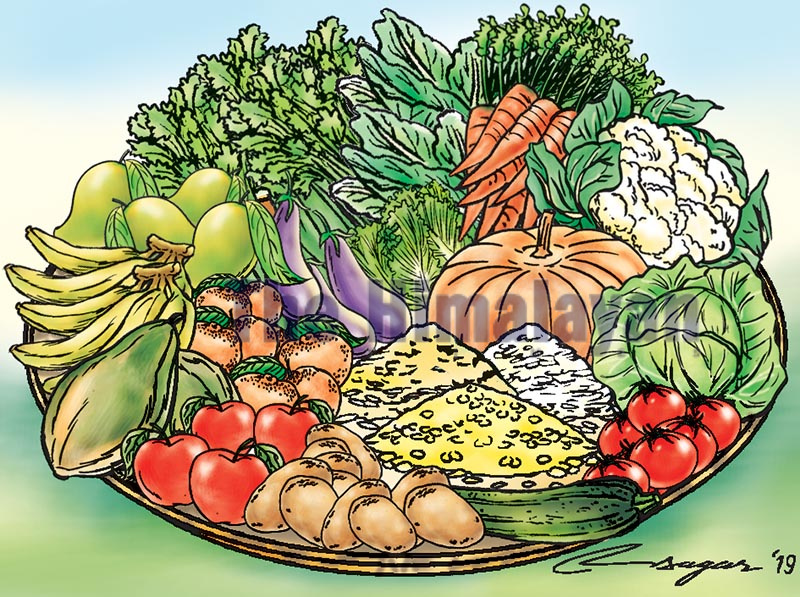Nutrition tray: A win-win for better health
Poshan Nanglo makes good nutrition visible by drawing attention to nutrient dense foods from diverse food groups that constitute a healthy diet. People get to see, touch and feel the real foods thereby having a multi-sensory experience
Two nutrition facts, important and interrelated, are crystal clear. Firstly, nutritious food is of paramount importance for our health and well-being, and secondly, our dietary pattern also influences the health and well-being of the planet. Recent ground-breaking and powerful reports by multi-disciplinary experts, especially from the EAT-Lancet commission and International Panel on Climate Change, have highlighted and reiterated these facts. This is much to the delight of those of us who are passionate about achieving good nutrition through a healthy sustainable diet and also being responsible towards the planet.
Many questions may come in the mind. So what do we do now - as individuals, as programmers and as policy makers? A precursor to every action is the need to understand and internalise the concept of good nutrition by everyone. Efforts have been made for decades to convey the right nutrition messages, yet there is much to be done. Different and more complex nutritional problems are also emerging. This should make us think – do we need to do things a little differently? In a more compelling yet simple way that embodies the essence of the Sustainable Development Goals. With this rationale, I have become a passionate proponent of a concept called Poshan Nanglo that translates as ‘nutrition tray’. Nanglo is a traditional bamboo tray that has been used by Nepali households since generations and denotes the association between food and agriculture. Poshan Nanglo is a simple concept of displaying nutritionally diverse, locally available and seasonal foods in their fresh and original form.
It is well established that the diversity of a nutritious diet maintains good health and protects one against diseases. Poshan Nanglo makes good nutrition visible by drawing attention to nutrient dense foods from diverse food groups that constitute a healthy diet. People get to see, touch and feel the real foods thereby having a multi-sensory experience. Multi-sensory learning has been proven by other disciplines like education to be more effective and thus deemed as a progressive method helping better retention of knowledge. Poshan Nanglo also conveys a much-needed message that good nutrition is possible from recognising, promoting and utilising nutritious local as well as indigenous foods, which are often forgotten and sidelined. This helps to empower the local communities on the nutritional potential of foods available around them.
Poshan Nanglo can also help to make positive contributions towards the environment. This approach in itself does not entail any printing. Encouraging people to consume wholesome and seasonal foods can gradually help to curtail the additional environmental burden associated with production, packaging and transporting of highly processed commercial foods. Excess meat consumption among the general adult population is now known to be related with several non-communicable diseases, which also has a high carbon foot print. Showcasing and educating about a variety of plant-based foods like legumes, nuts and seeds as alternatives using Poshan Nanglo can help to curb excess meat intake.
Improvement in the people’s health through a healthy diet in turn also minimises their medical care needs, thereby decreasing the associated carbon footprints, toxic chemicals and wastes. In addition, the display of nutritionally diverse food is attractive and is bound to garner the attention of crucial stakeholders like agriculture and the food industry. Agricultural diversity makes nutritious foods more available, and this has been understood as being beneficial for the soil as well as the environment. Consequently, Poshan Nanglo can help catalyse the production of nutritionally diverse foods.
Poshan Nanglo can be taken forward in a multi-pronged manner. It can be an effective tool for nutrition advocacy, nutrition capacity enhancement and for nutrition social behaviour change communication. Nutrition advocacy efforts can easily be accompanied and complemented by the Poshan Nanglo approach. Targeted stakeholders can visualise and comprehend the foods that entail good nutrition.
Similarly, Poshan Nanglo could be an effective training methodology to impart the knowledge of good nutrition and elucidate its possibility from the diverse range of local foods. This is bound to enrich the learning process for the participants and broaden their understanding of nutritious foods. Poshan Nanglo has enormous ability and simplicity as a nutrition social behaviour change communication tool. That ought to be fully harnessed by accelerating its incorporation in relevant multi-sector nutrition policies as well as programmes.
As a simple approach optimising local resources to promote good health with hardly any financial or environmental cost, Poshan Nanglo perfectly aligns itself with the essence of the Sustainable Development Goals. In view of the strong momentum for nutrition, increasing realisation of the role of a nutritionally diverse diet to address malnutrition in all its forms and new evidence of food as a powerful driver of environment sustainability, there is tremendous potential for this approach. Poshan Nanglo as a Nepali initiative can help carve a new positive identity for our country. Overall, I would say it is a multiple win-win!
Uprety is a nutritionist






